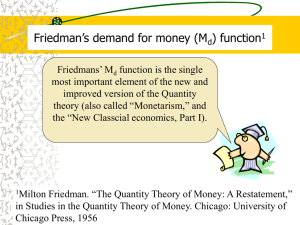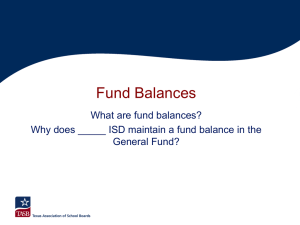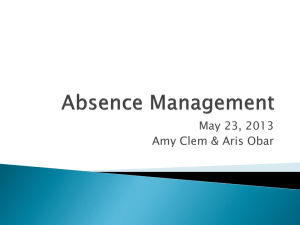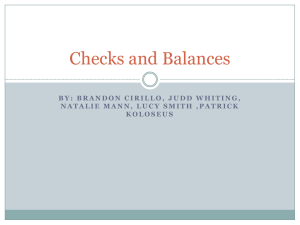Chapter 5 on energy balances
advertisement
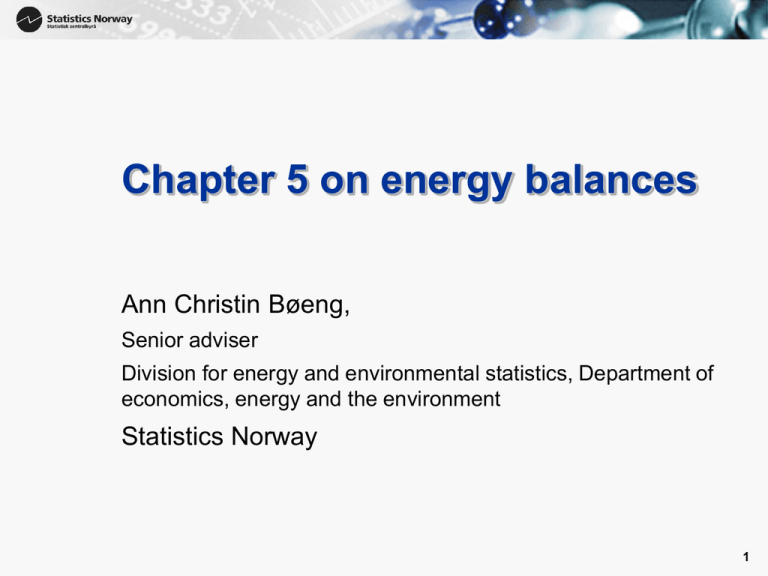
1 Chapter 5 on energy balances Ann Christin Bøeng, Senior adviser Division for energy and environmental statistics, Department of economics, energy and the environment Statistics Norway 1 Outline for this presentation • Work process with the chapter • Comments from last Oslo group meeting in Helsinki • Current structure in the chapter and changes since last meeting • Comments from the virtual meeting in April this year • Questions • First annotated outline of the chapter: Does the chapter follow UNSD’s planned outline. 2 Comments and discussion on last OG meeting • • • The first draft of chapter 5 was presented in Helsinki in October 2012. Statistics Norway wrote the main part of the first draft. The following countries / organizations volunteered to contribute; Country/Organization Representative IEA Karen Treanton Canada/Statistics Canada Andy Kohut China/ National Bureau of Statistics of China Xie Xin Cameroon/Ministère de l'Energie et de l'Eau (MINEE) Defo Wafo Sylvain Congo/Ministère de l'Energie Willy Kipoy S. Musalu Ghana/Energy Commission of Ghana Salifu Addo UK/UK Department of Energy and Climate Change (DECC) Iain MacLeay UNSD 3 Some of the comments from the meeting in Helsinki were the following: • Start with description of energy commodity balance and then explain how to convert it to an energy balance. • Ensure that the chapter follows IRES • It was a discussion whether the chapter should explain how to estimate the renewable energy share in the balance • IRES sais that the energy balance should contain an ”of this renewable” column, and it was agreed to explain this in the chapter. 4 Several comments on the chapter (continues) • Give more practical guidance on how to compile the balance • Explain better what an energy balance is and what is the purpose with it. • Include more country practices or refer to places where practical examples on how to do things could be found • Needs of some restructuring • Describe better conversion from physical units to energy units. • Describe ”energy losses” better! • Make it more easy to understand 5 Changes made in the chapter • A somewhat modified draft was published on the virtual meeting the 15th. April this year. There are now 4 main parts in the chapter and an appendix. • Part A: Introduction / Importance of energy balances. (one page) • Part B: General information pertinent to both commodity balances and energy balances (describes flows etc.) • Part C: Compilation of energy balances. • Part D: Country spesific examples • Appendixes 6 Part B: Information pertinent to both balances and commodity balances • • • • • • • • • • • • • 1. Level of detail 2. Yearly, quarterly or monthly balances? 3 Timeliness, preliminary and final balances 4. Scope of commodity balances and energy balances - 4.1 Energy products (SIEC) - 4.2 Energy flows 5 : Domestic supply and transfers (describes prod., bunkers etc.) 6. Transformation (examples on transformation processes) 7: Energy industries own use 8: Losses 9; Final consumption 10: Statistical difference 11: Possible elements for reconciliation 7 Part C Compilation of energy balances • • • • 1 Calculating an energy balance • 5 . Hydro pumped storage plants: Different treatment in balances and commodity balances • • 6 Example of an energy balance (EB for Austria as example) • • 8 Presentational issues in an energy balance (transformation, transfer) 2 Net or gross calorific values? (NCV recommended) 3 Choice of the primary energy form 4 Calculation of the primary energy equivalent : How to calculate nuclear, hydro, solar etc., when only the electricity produces is known. 7 Checking the energy balance (checking transformation losses, statistical difference, generation efficiency) 9 How to calculate the renewables column 8 Part D Country-specific examples • • • 1. Statistics Norway’s energy balance • • Appendix A. Heat production from heat pumps 2. Statistics Austria’s energy balance 3. Aggregated energy balance for the United Kingdom Appendix B. Calculation of the primary energy equivalent 9 Changes in the chapter • Most modifications was done by me and Karen Treanton in IEA (who has now retired- gone sailing) • The current draft now starts with describing commodity balances, before explaining how to compile energy balances. - One challenge was that existing recommendations on how to compile commodity balances are limited. Appendix C in IRES gives only a short general description of this. 10 Commodity balances • Energy commodity balances varies among countries. • Some countries present commodity balances separately for each energy product, while others present complete commodity balances for all products. • Most countries do not include the primary form of electricity and heat (hydro, wind, nuclear) in their commodity balances, but Eurostat does. • Most countries and institutions does also include both primary and secondary energy production in the top row in the commodity balance (but not Eurostat) 11 Several changes • The chapter gives a description on common practices for compiling commodity balances. • We approve that layouts may differ of various reasons, such as different preferences or energy situations in the countries • Furthermore; There is a lot of common elements in the energy balance and commodity balance; • Most of the flows and the products are the same, but it is just restructured, and presented in different units. • That is why we use the following title on part B of the chapter (which describes flows and contents in the balance) • - Information pertinent to both balances and commodity balances 12 Other changes in the draft • There are added more practical examples on certain technical issues, - such as calculating hydro and geothermal in the balance. • To convert from commodity balances to energy balances, it is necessary to calculate the primary energy equivalent (hydro, wind, sun, nuclear etc.) on basis of the output of electricity and heat. • This is described in part part C in the chapter. 13 Physical energy content method • The partial substitution method and physical energy content method is described. The physical energy content method is recommended. • It is added calculation example on how to calculate the primary energy equivalent for hydro, nuclear, wind, etc. on basis of electricity and heat output (in table 5.5) • This is simply done by converting the primary energy products to a joint unit; Petajoule • No losses are assumed for hydro and wind, but for nuclear and geothermal it is assumed losses (efficiency = 33 % for nuclear and 10 % for electricity from geothermal) 14 Table 5.5 Calculation of primary energy using the physical energy content method Non-combusted products Electricity output (GWh) Equation Primary energy equivalent in PJ Nuclear 0 =(0*.0036)/0.33 0 Hydro 41596 =(41596-3190)*0.0036 138.26 (of which pumped storage) 3190 Solar PV not included in energy balance 89 =89*0.0036 0.32 2064 =2064*0.0036 7.43 Geothermal 1 =(1*0.0036)/0.1 0.04 Solar thermal 0 =(0*0.0036) 0 Heat output (TJ) Equation Primary energy equivalent in PJ 538 =(538/1000)/0.5 1.08 0 =(0/1000)/0.5 0 Wind Non-combusted products Geothermal Solar thermal 15 Conversion • This means that for 10 PJ electricity produced from geothermal we need an input of 100 PJ geothermal. • These efficiencies are provided by IEA. However, I think the efficiencies used may vary among countries. Conversion from tonnes to PJ; • It is also added tables (table 5.4) that shows how to convert oil products from physical units to energy units (by multiplying with the net calorific value) for energy balance purposes. • Net calorific values are taken from IRES. 16 Validation rules • It is included several validation practices in the balance; - Such as checking efficiency in transformation processes (for instances refinery plants) . Losses should not be too large or too small and it should not be an energy gain. • In refineries the losses in the transformation process from crude oil to oil products, should be around 0.5-2 per cent. • It is also added a table with expected generation efficiency in thermal power plants and heat plants. • Statistical differences is another useful check for the balance 17 Other changes • There is included a section on how to calculate the renewable part of the balance in the chapter. • This is a challenge for electricity, because it might be traded among countries. • A few countries are very dependent of imported electricity • In the chapter we propose that countries should calculate the RE part of electricity according to the renewable production in the country. 18 Renewable column • However, if the country are very dependant of electricity imports, it might be wrong to calculate this share on basis of production. • One solution is to assume that all imported electricity is nonrenewable. • Another possibility is to estimate the RE-share in imported electricity (on basis of production technology in the countries) and take also this into account . This is proposed in cases were import dependency of electricity is high. • Other changes in the draft: • There are added country practices; for Austria, Norway, Azerbaijan and UK. 19 Comments during the virtual meeting • During the virtual meeting from 15. April 2013, we got comments from UK, Poland, Ireland, UNSD and Egypt • First of all; • Many thanks to all who have given comments; • They were all very useful 20 Some of the comments • Proposal to recommend countries to include heat pumps in the energy balance • Better explanation of stocks (as in IRES) • How to allocate fuels input between electricity and heat ion CHP plants • Calculation of renewable part of electricity, taking trade into account. • Correct errors in the renewable table (table 5.9) • Remove repeating text about heat pumps • Some restructuring of the introduction part of the chapter 21 Other comments • Give better explanations certain places or rephrase some of the text. • Use the term ”energy products” (not energy commodities) everywhere in the chapter. • Emphasize, and describe annual energy balance before quarterly or monthly balances • Better explanations of treatment of electricity in hybrid cars. • Consider the text on backflows / petrochemical plants (is it necessary to explain it) • Delete appendix C on calculation of ”useful energy” 22 Comments • Most comments are implemented; • However, I do not recommend to include energy from heat pumps in energy balances, due to the uncertainty in the calculations, but it is recommended to have additional tables for it. Furthermore, IRES doesn’t recommend it to be included. • Explanation of electricity used in hybrid cars are challenging. This text could be reviewed 23 Current text on hybrid cars; • Electricity in hybrid cars and electric motor cars: Hybrid cars have a battery and produce their own electricity from fossil fuels. Own electricity production from fossil fuels in the car should not be included in energy balances. Certain hybrid cars (plug-in hybrid cars) can also be charged, in addition to that they can produce their own electricity. Electricity charged by plug-in hybrid cars and electric motor cars should be estimated and included as electricity consumption in road transport in the energy balance. The figures can be estimated on basis of mileages (for instance from the vehicle registry) and information about electricity charged per km. driven (usually around 0,2 kWh/km). Furthermore, it is necessary with surveys that indicate how much plugin hybrid cars are charged vs. producing its own electricity. The surveys must also contain information on where the cars are charged. If the cars are charged at home 30 per cent of the time, the corresponding quantity of electricity has to be deducted from electricity consumption in households, in order to avoid double counting of electricity. 24 Some points for discussion • Heat pumps in energy balances • Calculation of electricity i hybrid cars • Calculation of renewable electricity consumption • Efficiencies used to calculate the primary energy equivalent (hydro, nuclear, geothermal etc.) on basis of the output of electricity and heat. Are they the same for all countries / institutions ? • Does the current chapter follow the earlier outlines of the chapter? • Other things? 25 Memorandum of annotated draft outline of chapter 5 (which was tabled at the OG meeting in canada 2009) • Chapter 6 Compilation of energy balances • This chapter will provide details on good practices in compilation of various types of energy balances focusing on the reconciliation of data obtained from different sources and other technical issues. Examples of energy balances compiled by several countries will be included. • Also, the balance formats used by UNSD, IEA and Eurostat will be presented together with a correspondence between them and the rationale for use of these formats. 26 More detailed guidelines for chapter 5, prepared by UNSD and the OG secretariat says the following; This chapter will provide practical guidance for the compilation of energy balances. In particular, it will describe how to use the data items presented in Chapter 6 of IRES (and discussed in Chapter 4 of the ESCM) in the balances. Data editing and the validation rules inherent to the energy balances will also be addressed here. This chapter will also discuss secondary data sources that can be used for the compilation of balances when only partial data items are available, as well as associated data estimation and reconciliation methods. 27 outline by UNSD / OG secretariat continues. • A. Commodity balances How to compile commodity balances from the data items in Chapter 4. In the absence of some of the data items, this section will describe secondary sources that can be used for compiling the commodity balances • B. Energy Balances How to go from commodity balances to energy balances; description of the methods for setting the value of primary energy (physical energy content vs. partial substitution methods), use of calorific values; • C. Validation rules 28 Thank you for your attention Contact info: Ann Christin Bøeng. E-mail: abg@ssb.no 29


